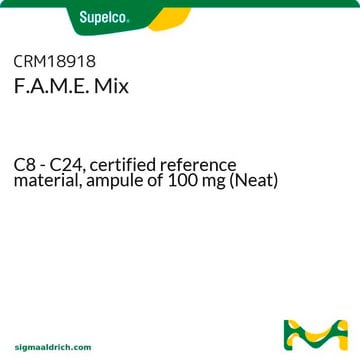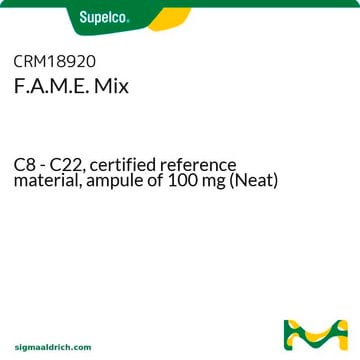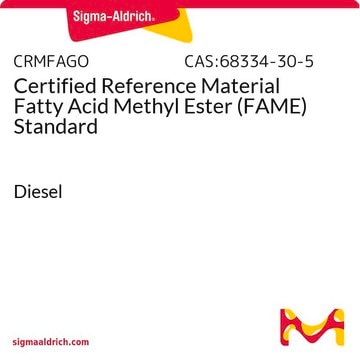SMB00937
Fatty Acid Methyl Esters Standard Mixture
Synonyme(s) :
FAME, fatty acids, standard mixture
About This Item
Produits recommandés
Forme
liquid
Niveau de qualité
Conditionnement
pkg of 1 vial
Solubilité
soluble, clear, colorless
Température de stockage
-10 to -25°C
Catégories apparentées
Description générale
Application
Gas chromatography-mass spectrometry (GC-MS)-based metabolomics is used to identify and quantify small-molecule metabolites such as small acids, alcohols, hydroxyl acids, amino acids, sugars, fatty acids, sterols, catecholamines, drugs, and toxins.
Fatty acid methyl esters used in this standard showed a strong, consistent m/z 87 ion and molecular ions which could be used to differentiate the individual peaks.
Autres remarques
Analyte
Mention d'avertissement
Danger
Mentions de danger
Classification des risques
Acute Tox. 3 Inhalation - Acute Tox. 4 Oral - Carc. 2 - Eye Irrit. 2 - Repr. 2 - Skin Irrit. 2 - STOT RE 1 Oral - STOT SE 3
Organes cibles
Central nervous system, Liver,Kidney
Code de la classe de stockage
6.1D - Non-combustible acute toxic Cat.3 / toxic hazardous materials or hazardous materials causing chronic effects
Classe de danger pour l'eau (WGK)
WGK 3
Point d'éclair (°F)
Not applicable
Point d'éclair (°C)
Not applicable
Choose from one of the most recent versions:
Certificats d'analyse (COA)
Don't see the Right Version?
If you require a particular version, you can look up a specific certificate by the Lot or Batch number.
Déjà en possession de ce produit ?
Retrouvez la documentation relative aux produits que vous avez récemment achetés dans la Bibliothèque de documents.
Notre équipe de scientifiques dispose d'une expérience dans tous les secteurs de la recherche, notamment en sciences de la vie, science des matériaux, synthèse chimique, chromatographie, analyse et dans de nombreux autres domaines..
Contacter notre Service technique






